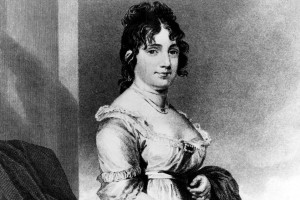WSJ Historically Speaking: The First Ladies and Their Predecessors
Dolley Madison was born this month in 1768. One of the greatest first ladies in U.S. history, she had a style and energy that brought a uniquely American twist to the role of political spouse. She transformed the White House, not only giving the interiors a much-needed face-lift but also making the presidential residence the social epicenter of Washington, D.C. Among her many gifts to the nation was her insistence that George Washington’s portrait be rescued when the British burned the city in 1814.
But Dolley Madison’s greatest achievement was in creating the role of first lady. President Zachary Taylor used the term for the first time at her funeral in 1849. After her time in the White House, Americans expected first ladies to play a public part, one that was above day-to-day politics and often national in its scope.
The idea of the political spouse has deep historical roots. Livia Drusilla, the ruthless and powerful wife of Caesar Augustus, was instrumental in shaping the destiny of the Roman Empire. Yet even she was imitating a role model that had its original expression in ancient Mesopotamia, the cradle of civilization.
One of the earliest recorded political spouses was the tireless Queen Shibtu (fl. 1775 B.C.), wife of King Zimri-Lim of Mari (in what is now Syria). The king was often away on military campaigns, leaving Shibtu in charge. His frequent absences meant that the two exchanged a treasure trove of letters, revealing a relationship that was practical and loving, as in this missive from Shibtu: “All is well at the palace. All is well, too, with the temples of the gods and the workshops. I have had omens read for the health of my lord. These omens are good…but my lord must take good care of himself when he is in the full sun.”
Shibtu laid the foundational elements for all subsequent political wives: a woman who is both the loyal helpmeet of her husband and a force in her own right. More than 2,000 years later, the example Shibtu set could be seen in Byzantium, where Empress Theodora (500-548) provided her emperor husband, Justinian, with the courage and backbone to meet the threats—from plagues to riots—that beset Constantinople.
During the medieval ages, Eleanor of Aquitaine(c. 1122-1204) gave the listless Louis VII of France the spirit he lacked, although she eventually divorced him in disgust. In Spain, Isabella I (1451-1504) ruled jointly with Ferdinand II, bringing untold wealth to one half of the country and untold misery to the other. In 1711, Russia’s Catherine I saved Peter the Great’s army from total annihilation by the Turks with the use of a judicious bribe.
By the time Dolley Payne Todd married James Madison in 1794, behind many a successful politician was a hardworking political wife. But not all U.S. presidents got the message. During the drafting of the Constitution, Abigail Adams told her husband John that unless women’s rights were also included, American women were “determined to foment a rebellion.” John Adams paid no attention, and her plea went unanswered until 1920.
Since American women won the right to vote, first ladies have been more prominent than ever, leading to a roster of celebrated political wives: Eleanor Roosevelt, Jacqueline Kennedy, Betty Ford, Nancy Reagan and, of course, Hillary Clinton.
It remains to be seen whether the role of first lady will change if and when the White House gains a first gentleman.

